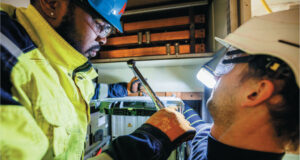OWE FORSBERG, IDCON, INC.
Developing an organization’s work processes is a key component of the management function. Without these processes there are no clear expectations for how work should be performed, who should be doing what (i.e., everyone’s roles), and who is responsible for the outcomes.
We have identified five key steps that blend together people, work processes, and technology to give your organization a solid reliability and maintenance foundation.

Figure 1: A partial ‘Schedule Work’ work process flow. Notice how the workflow identifies the role, the person responsible for the activity, and the outcomes.
1. DEVELOP A WORKFLOW
The workflow should line up your resources with work to be accomplished. IDCON’s Current Best Practices identifies the key steps in the work order flow (see Fig. 1.) These
steps are:
a. Identify work
b. Prioritize and approve work
c. Plan work
d.Manage backlog
e. Schedule work
f. Execute work
g. Record work completed
h. Improve and trigger Root Cause Problem Elimination (RCPE)
2. CLARIFY ROLES AND RESPONSIBILITIES
One effective way to clarify roles and responsibilities is to make a RACI Chart (Fig. 2). RACI stands for “Responsible—Accountable—Consulted—Informed.” The RACI chart will be used to identify each position’s role in the workflow. A clear workflow process removes the confusion and tension that can happen when people are not sure of what to do. Each task in the RACI chart will then be transferred to the job description for each position.

Figure 2: A RACI chart of the ‘Schedule Work’ work process.
3. GET PEOPLE TO FOLLOW THE WORKFLOW AND EXECUTE THEIR ROLE
For anyone who has ever supervised or managed a group of people, you understand that this is the most challenging step of the process. I believe the adage that states, “To improve reliability through better maintenance is 90 percent about people and processes and 10 percent about technology.”
People need to have the right ability, skills, and motivation to execute according to the workflow. You must hire the right people, invest in their training and development, and support them to stay motivated.
4. INTRODUCE THE LATEST TECHNOLOGY TO IMPROVE EFFICIENCY
Technology can be anything such as new automated equipment, a new condition monitoring tool, or a new CMMS. Referring back to the first three steps, you may need to add the new technology to your workflow, update your RACI charts, and invest in training your people on the new technology so they use it.
5. SELECT AND IMPLEMENT KEY PERFORMANCE INDICATORS (KPIS)
The right KPIs allow you to monitor your improvements and reach your targets or goals. There are two types of indicators your organization should implement: leading and lagging.
Leading indicators drive the right behavior in your organization and follow the workflow. Examples of leading indicators are:
• Work order initiated from PM or condition monitoring routes
• Backlog hours
• Shutdowns completed on time
• Training targets met
Lagging indicators measure business outcome. These ensure that you are competitive and successful. Example of lagging indicators:
• OEE—uptime, rate of production, and on-quality product
• Maintenance cost per ton or product output
We look forward to hearing how you are implementing these key steps! If you have already implemented them, let us know the challenges and successes you’ve had.
 Paper 360
Paper 360
